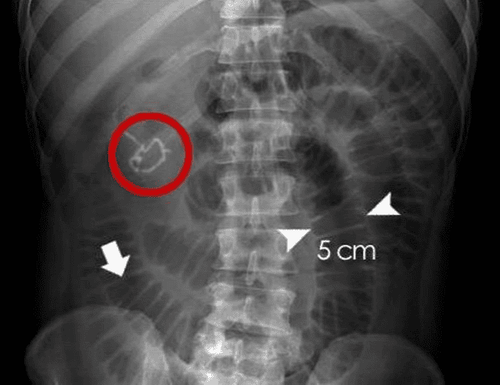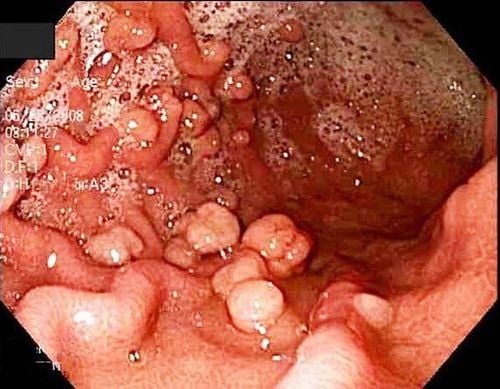This is an automatically translated article.
The article was professionally consulted by Specialist Doctor I Tran Cong Trinh - Radiologist - Radiology Department - Vinmec Central Park International General Hospital. The doctor has many years of experience in the field of diagnostic imaging.Although the small intestine is a large part of the gastrointestinal tract, small bowel tumors are rare, accounting for only 3% to 5% of all gastrointestinal tumors. Unlike esophageal, gastric, and colorectal tumors, most small bowel tumors are diagnosed only by means of morphological examination. With the current medical conditions in Vietnam, X-ray and computed tomography are the best and most popular means of diagnosing small bowel tumors.
1. Small bowel tumor is a disease like?
The small intestine is a long, curled tubular organ (average length 6.5m), carrying the task of digesting food from the stomach down. This is the part of the alimentary canal located between the stomach and the large intestine.Small bowel tumors begin to form when cells in the small intestine grow out of control. According to the survey, this is a rare disease and is difficult to diagnose by conventional imaging methods. Small bowel tumors account for only 3% to 5% of all gastrointestinal tumours.
If the tumor is small in size and has not invaded widely, patients with small bowel tumors will only present with non-specific clinical symptoms. Symptoms may include:

Khối u ruột non lớn sẽ gây triệu chứng tắc ruột
When the tumor forms in the small intestine, it can obstruct the flow of food, thereby affecting digestion. . Larger tumors can cause intestinal obstruction, which requires emergency surgery. If the tumor in the small intestine bleeds, it will eventually cause anemia. Another complication of small bowel tumors is perforation of the hollow viscera. Weakens the immune system: Tumors of the small intestine lead to abdominal pain, fatigue, and poor absorption of food, thereby weakening the immune system. Other diseases may also arise because of this condition.
2. Common types of small bowel tumors on X-ray

X quang ruột non giúp chẩn đoán u ruột non
Through X-ray images, the doctor will capture some imaging features that help to suggest the tissue nature of the small bowel tumor and may find that the lesion morphology is the most important feature to help distinguish the small bowel tumor. differentiate u groups. Due to the origin of tumors growing from different layers of the intestinal wall, through morphological analysis the predominant lesion will help to suggest the type of small bowel tumor. Accordingly, small bowel tumors are divided into 2 types:
Benign tumors Malignant tumors 2.1. Benign small bowel tumors Benign adenomas account for about 25%, which can include: lipomas, leiomyomas, neurofibromas, fibroids and intestinal polyposis.
Benign tumors can be asymptomatic and are sometimes discovered incidentally at the time of surgery or surgery.
All of the above tumors are fortunately benign, but they can still cause pain, abdominal distension, bleeding, diarrhea and if obstructed, the patient will vomit. In addition, polyps in the small intestine are not as common as those in the colon. To treat these tumors, your doctor will use surgical removal.

Bệnh đa polyp ruột thuộc loại u lành tính
Adenocarcinoma: this is the most common malignancy in the small intestine, accounting for about 30-50%, occurring most often in the duodenum and jejunum. Symptoms are obstruction or bleeding. Sarcoma: This is the most common tumor in the mid-small intestine, and may first present as tumor, obstruction, and hemorrhage. Intestinal lymphoma: This type of tumor presents for the first time as either obstruction or hemorrhagic. Intestinal perforation or malabsorption may also occur. Gastrointestinal tumors: are cancers that can arise in other locations in the stomach and colon. The cure rate for all types of melanoma is low or bad. As with benign tumors, doctors will use surgical excision to remove these tumors.
Small bowel tumors are mostly detected at a late stage of the disease due to vague clinical manifestations or no symptoms until complications appear, making it difficult to detect the disease at an early stage. Statistics show that half of all benign small bowel tumors are discovered incidentally through endoscopy or surgery.
In short, small bowel tumor is a rare disease but very dangerous. Patients need to be diagnosed and detected promptly to limit the risk of possible disease complications. Accordingly, X-ray, small bowel computed tomography is an imaging technique to help find, detect, evaluate, classify and determine the stage of small bowel tumor quickly and accurately. .

Tầm soát sớm ung thư đường tiêu hóa tại Bệnh viện Đa khoa Quốc tế Vinmec
Gastroenterology specialist examination (by appointment) Gastroscopy and colonoscopy with NBI endoscope with anesthesia Gastroscopy and colonoscopy with anesthesia (Drugs) Gastroscopy and colonoscopy with anesthesia (VTTH) Routine histopathological examination fixed, transferred, cast , cut, stain... biopsies (upper gastrointestinal tract (esophagus, stomach, duodenum, papilla) through endoscopy Routine histopathological examination is fixed, transferred, cast, cut, and stained. ..biopsy specimens (lower gastrointestinal tract through endoscopy (colon, rectum) Accordingly, the entire examination process is performed by a team of highly qualified and experienced doctors, and at the same time has comprehensive cooperation with domestic and international hospitals: Singapore, Japan, USA, .. Therefore, customers can be completely assured with the methodical examination process at Vinmec.
Please dial HOTLINE for more information or register for an appointment HERE. Download MyVinmec app to make appointments faster and to manage your bookings easily.













